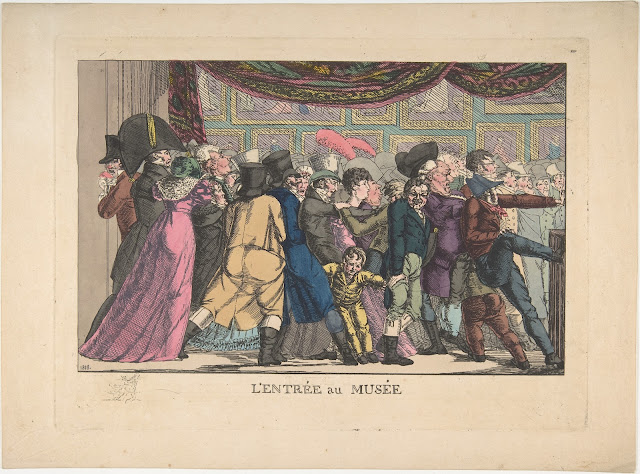 |
| Richard Earlom after Michel Vincent Brandoin Royal Academy exhibition in London 1772 mezzotint British Museum |
 |
| Anonymous printmaker L'Entrée au Musée 1808 hand-colored etching Metropolitan Museum of Art, New York |
 |
| Thomas Rowlandson Exhibition Room, Somerset House (annual Royal Academy exhibition in London) 1808 hand-colored etching and aquatint Metropolitan Museum of Art, New York |
 |
| Veuve Chéreau (publisher) La famille Anglaise au Museum à Paris (An English family at the Louvre) 1814 hand-colored etching British Museum |
 |
| Louis-Philibert Debucourt after Carle Vernet Visitors to the Salon Exhibition in Paris, admiring the ceiling 1824 hand-colored etching Metropolitan Museum of Art, New York |
 |
| J. Findlay and S.G. Hughes Fashion Plate set in newly-opened Phigalian Room of the British Museum, with Elgin Room beyond 1832 hand-colored etching and aquatint British Museum |
 |
| Thomas Hosmer Shepherd Reading Room of the British Museum (the sixth Reading Room, in use from 1838 to 1857) ca. 1840 watercolor British Museum |
" . . . and so the characteristics of human beings are to be counterpoised as alien to one another, and so the harmony of the spheres resounds from their orbits, which do not come into contact with one another. Every essential being is a sun and relates to beings like itself, as suns in fact relate to one another. This also applies in the realm of philosophy, which is the only realm in which the truth becomes manifest, namely with a sound like music. And this is the harmonic concept of truth, which we must acquire so that the false quality of watertightness that characterizes its delusion vanishes from the authentic concept, the concept of truth. The truth is not watertight. Much that we expect to find in it slips through the net."
– Walter Benjamin, from manuscript draft of Language and Logic (1921), reproduced in Walter Benjamin's Archive, translated by Esther Leslie (Verso, 2007)
 |
| A.O. Driscoll after Elijah Shaw Entrance Gate, British Museum (Montague House, with porter William Scivier) 1842-43 lithograph British Museum |
 |
| George Goodwin Kilburne Mother and daughter with Demeter statue in the Mausoleum Room, British Museum before 1884 watercolor British Museum |
 |
| John Sloan Connoisseurs of Prints 1905 etching British Museum |
Types of Knowledge
I
The knowledge of truth. This does not exist. For truth is the death of intention.
II
Redemptive knowledge. This is the knowledge that dawns with redemption, which is thereby completed. But it is not the knowledge that precipitates redemption.
III
Teachable knowledge. Its most significant form of appearance is banality
IV
Determining knowledge. There is knowledge that determines action. It is, however, not determining as a "motive," but rather due to the force of its linguistic structure. The linguistic moment in morality is connected to knowledge. It is absolutely certain that this knowledge that determines action leads to silence. Therefore, as such, it is not teachable. This determining knowledge is closely related to the concept of Tao. This is in direct contradiction to knowledge in Socrates' Doctrine of Virtue. While this is motivating for action, it does not determine those who act.
V
Knowledge from insight or perception. This type is highly enigmatic. In the region of knowledge, it is something that resembles the present in the region of time. It exists only as an ungraspable transition. From what to what? Between foreboding and the knowledge of truth.
– Walter Benjamin, from manuscript outline headed Types of Knowledge (1921), reproduced in Walter Benjamin's Archive, translated by Esther Leslie (Verso, 2007)
 |
| François Courboin À la bibliothèque (woman studying an album at Bibliothèque Nationale, Paris) 1906 etching, drypoint British Museum |
 |
| Muirhead Bone Egyptian Saloon (with scaffolding), British Museum ca. 1906 drawing British Museum |
 |
| Frederick Hans Haagensen British Museum 1932 drypoint British Museum |
